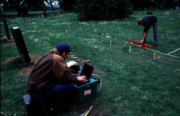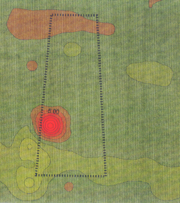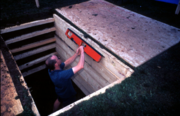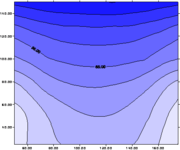
Exhumation of Yagan's head
Encyclopedia


Archaeological geophysics
Geophysical survey in archaeology most often refers to ground-based physical sensing techniques used for archaeological imaging or mapping. Remote sensing and marine surveys are also used in archaeology, but are generally considered separate disciplines...
and archaeological
Archaeology
Archaeology, or archeology , is the study of human society, primarily through the recovery and analysis of the material culture and environmental data that they have left behind, which includes artifacts, architecture, biofacts and cultural landscapes...
dig at a grave site in the Everton Cemetery
Everton Cemetery
Everton Cemetery, Long Lane, Fazakerley. Opened in July 1880 it has been used for both Church of England and Roman Catholic burials. Various buildings at the cemetery are Grade II listed buildings.-External links:...
, Liverpool
Liverpool
Liverpool is a city and metropolitan borough of Merseyside, England, along the eastern side of the Mersey Estuary. It was founded as a borough in 1207 and was granted city status in 1880...
in 1997.
Background
YaganYagan
Yagan was an Australian Aboriginal warrior from the Noongar tribe who played a key part in early indigenous Australian resistance to British settlement and rule in the area of Perth, Western Australia. After he led a series of burglaries and robberies across the countryside, in which white...
was an indigenous Australian
Indigenous Australians
Indigenous Australians are the original inhabitants of the Australian continent and nearby islands. The Aboriginal Indigenous Australians migrated from the Indian continent around 75,000 to 100,000 years ago....
warrior of the Noongar
Noongar
The Noongar are an indigenous Australian people who live in the south-west corner of Western Australia from Geraldton on the west coast to Esperance on the south coast...
nation who played a key part in early indigenous resistance to European settlement and rule around the area of Perth, Western Australia
Perth, Western Australia
Perth is the capital and largest city of the Australian state of Western Australia and the fourth most populous city in Australia. The Perth metropolitan area has an estimated population of almost 1,700,000....
. He was shot dead by a settler in 1833, and his head was removed and sent to England for display in a museum.
By 1964, Yagan's head was badly decomposed, and the decision was made to dispose of it. The head was placed in a plywood
Plywood
Plywood is a type of manufactured timber made from thin sheets of wood veneer. It is one of the most widely used wood products. It is flexible, inexpensive, workable, re-usable, and can usually be locally manufactured...
box, along with a Peru
Peru
Peru , officially the Republic of Peru , is a country in western South America. It is bordered on the north by Ecuador and Colombia, on the east by Brazil, on the southeast by Bolivia, on the south by Chile, and on the west by the Pacific Ocean....
vian mummy
Mummy
A mummy is a body, human or animal, whose skin and organs have been preserved by either intentional or incidental exposure to chemicals, extreme coldness , very low humidity, or lack of air when bodies are submerged in bogs, so that the recovered body will not decay further if kept in cool and dry...
and a Māori head
Mokomokai
Mokomokai are the preserved heads of Māori, the indigenous people of New Zealand, where the faces have been decorated by tā moko tattooing. They became valuable trade items during the Musket Wars of the early 19th century.-Moko:...
, and buried in Everton Cemetery's General Section 16, grave number 296. In later years, a number of burials were made around the grave, and in 1968 a local hospital buried 20 stillborn babies and two babies who had lived less than twenty-four hours, directly over the museum box.

Next of kin
Next of kin is a term with many interpretations depending on the jurisdiction being referred to. In some jurisdictions, such as the United States, it is used to describe a person's closest living blood relative or relatives...
permission to disturb the remains of the twenty-two babies could not be obtained.
The geophysical survey


University of Wales, Lampeter
University of Wales, Lampeter is a university in Lampeter, Wales. Founded in 1822 by royal charter, it is the oldest degree awarding institution in Wales and may be the third oldest in England and Wales after Oxford and Cambridge...
and Dr Richard Bates of the University of St Andrews
University of St Andrews
The University of St Andrews, informally referred to as "St Andrews", is the oldest university in Scotland and the third oldest in the English-speaking world after Oxford and Cambridge. The university is situated in the town of St Andrews, Fife, on the east coast of Scotland. It was founded between...
, were commissioned by the Home Office
Home Office
The Home Office is the United Kingdom government department responsible for immigration control, security, and order. As such it is responsible for the police, UK Border Agency, and the Security Service . It is also in charge of government policy on security-related issues such as drugs,...
to conduct a geophysical survey
Archaeological geophysics
Geophysical survey in archaeology most often refers to ground-based physical sensing techniques used for archaeological imaging or mapping. Remote sensing and marine surveys are also used in archaeology, but are generally considered separate disciplines...
of the grave site, with a view to exhuming the remains via an adjacent plot without disturbing any other remains.
The pair conducted surface surveys using ground penetrating radar and ground conductivity techniques. The ground penetrating radar yielded no information about the location of Yagan's head, as the highly disturbed graveyard soil contained many reflecting sources. However, the ground conductivity measurements showed an anomaly in the electromagnetic signature that it was thought might be caused by metal artifacts buried with the head. The apparent location of the remains confirmed the feasibility of accessing them via an adjacent plot.
A pit was then dug in an adjacent plot, to a depth of around six feet, and a vertical ground conductivity test was conducted from within the pit. This test failed to detect the anomaly recorded in the surface test, however the conductivity plot did show an anomaly at the centre of the grave, indicating that the grave was dug to its full depth of nine feet only at its centre. This suggested the burial of a small box, confirming the memory of the grave digger who claimed to have constructed a small box to house the buried remains.
The exhumation
After gathering evidence on the position and depth of Yagan's head, Bates reported the survey results to the Home Office, which eventually granted permission to proceed with the exhumation. Yagan's head was exhumed by tunnelling horizontally into the grave from the adjacent pit. The tunneling operation was "delicate and risky", as the tunnel passed underneath the remains of the babies, such that any collapse could potentially disturb them. According to Richard Bates, "the first shovel of dirt from the grave showed signs of the decayed box and the Peruvian mummy came next followed by the Māori head and finally Yagan's head".The following day, a forensic
Forensics
Forensic science is the application of a broad spectrum of sciences to answer questions of interest to a legal system. This may be in relation to a crime or a civil action...
palaeontologist from the University of Bradford
University of Bradford
The University of Bradford is a British university located in the city of Bradford, West Yorkshire, England. The University received its Royal Charter in 1966, making it the 40th University to be created in Britain, but its origins date back to the early 1800s...
positively identified the skull as Yagan's, by correlating the fractures with those described in an 1834 report by Thomas Pettigrew
Thomas Pettigrew
Thomas Joseph Pettigrew , sometimes known as "Mummy" Pettigrew, was a surgeon and antiquarian who became an expert on Ancient Egyptian mummies...
.
Aftermath
Later that year, Yagan's head was handed over to a delegation of Noongars, who took it back to Australia. Reburial of the head has been delayed, however, due to uncertainty of the whereabouts of the rest of his body and disagreement by elders about the importance of burying the head with the body. They finally buried it in July 2010, in a traditional Noongar ceremony in the Swan Valley in Western Australia, 177 years after Yagan's death.Further reading
The following source was not consulted in the writing of this article:- Bates, M and Bates, C. R. (1997) A Report on the Geophysical Investigation of the Site of a Grave in Everton Cemetery, Liverpool, Unpublished Technical Report.

